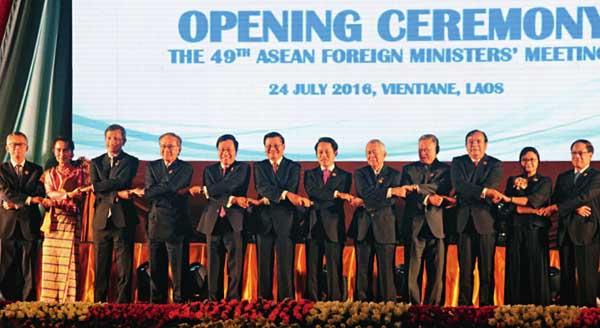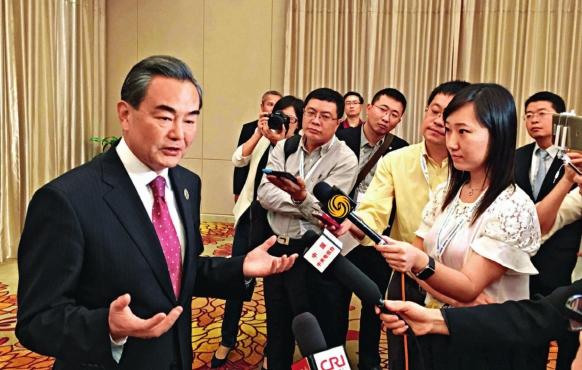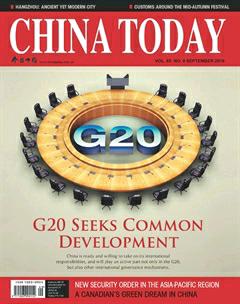New Security Order in the Asia-Pacific Region
By HE YAFEI


THE Belt and Road Initiative, whose guiding principle is "jointly building through consultation to meet the interests of all" has been warmly welcomed by the countries along the routes. The total volume of bilateral trade between China and other countries involved in this program hit US $995 billion in 2015, accounting for 25.1 percent of Chinas foreign trade that year. Meanwhile, Chinese companies made direct investments worth US $14.82 billion in countries along the routes, an 18.2 percent increase over 2014. Over the same period, investment in China from countries in this region rose by 23.8 percent to US $8.46 billion. More cooperation is likely to benefit people on all sides, as the program is being implemented in a substantial way.
As a foundation for multilateral cooperation, a peaceful and stable security environment in the Asia-Pacific region plays an essential role in building up the Belt and Road strategy. Influenced by geopolitics, however, the region is experiencing a complicated and sensitive security situation at present. There is a long way to go to establish a new order for regional security.
The Asia-Pacific Security Situation
The Asia-Pacific region has witnessed rising "turbulence" and "disorder" in its security in recent years. For instance, the intensified South China Sea disputes and the deployment of the Terminal High Altitude Area Defense (THAAD) in South Korea have caused particular concern. Several reasons have been given for the worsening situation.
First of all, the strategy of "rebalancing toward the Asia-Pacific region," put forward by the U.S., has strengthened its military alliances with countries such as Japan, the Philippines, and Australia. This has not only destroyed the strategic balance and relatively stable status in the region, but intensified geopolitical conflicts, as well as disputes over sovereignty and maritime rights and interests.
In his article “The Case for Offshore Balancing,” published in Foreign Affairs, John J. Mearsheimer from the University of Chicago elaborates on the U.S. global strategies. He points out that in Europe, the U.S. exercises its restraints upon Russia while in Asia it mainly puts effort into"balancing" Chinas ascendancy to prevent it from growing into a super power in the region which could challenge the dominant role of the U.S.
In fact, since the end of the Cold War, neo-conservatism and offensive realism have dominated U.S. policy toward the Asia-Pacific region – centered on tackling the rise of China and equipped with a strategy of"offshore balancing." The U.S. intended to set up a NATOlike organization in Asia when the Cold War ended, but it had to lay more stress on the war on terror worldwide after the 9/11 attacks of 2001. The policy towards the AsiaPacific region was accordingly adjusted.
A retrenchment began when President Barack Obama took office in 2009. The U.S. ended the war in Iraq and set a schedule to withdraw its troops from Afghanistan. In 2010, the U.S. government put forward the strategies of "returning to Asia" and "rebalancing toward the AsiaPacific region," so saliently revealing its goal of containing Chinas development, which is deemed as a potential"threat" to U.S. hegemony.
Recently, the U.S. meddled in the South China Sea disputes by flaunting its force and backing the Philippines in the Hagues arbitration. On top of that, it decided to deploy THAAD in South Korea – a move to sabotage the regional strategic balance and make it more difficult to achieve peaceful settlement of the nuclear issue on the Korean Peninsula.
No matter who wins the presidential election, the new U.S. government will have to make a choice between carrying out isolationism and continuing to “police” the world. The U.S. usually adopts isolationism when it experiences setbacks in its foreign strategy. Yet it is now hard and impracticable to return to its former isolationism as todays world is closely interdependent in its economy and security. Either way, it is not likely that the U.S. will change its security strategy in the Asia-Pacific. The regions security architecture based on military alliances with the U.S. will be reinforced, which is a truth China should not ignore.
Second, Japanese Prime Minister Shinzo Abe expects to restore Japans dominance in the region by means of"grappling" with China and reinforcing its military force, echoing the strategy of "rebalancing toward the Asia-Pacific region." Yet it has had an adverse impact on regional security.
Insistent upon overturning the Yalta System and the East Asian order established after WWII, Japan is reluctant to face the truth that it initiated the war. Such an attitude has not only increased tension between Japan and its neighbors, but also damaged its own interests. Further, Japan has obstinately adopted a confrontational stance on the issues of the East China Sea and Diaoyu Islands. Together with the U.S., it has interfered in the South China Sea disputes, supported the Philippines to escalate the issue, and taken part in a joint naval patrol of the South China Sea. It has thus been detrimental to regional peace and the construction of a new regional security order.
Third, the existing security architecture in East Asia is moving further away from the regional economic development framework, creating an odd situation where the region depends on China for economic progress while relying on the U.S. in the security sector.
It is a win-win outcome that Chinas neighboring countries have shared substantial benefits generated by Chinas fast development and its long-standing goodneighborly policy. Calling for the building of a community of common interests and common destiny, as well as putting forward the Belt and Road Initiative, China welcomes other countries – neighboring countries in particular – to take a free ride on its achievements. However, the security strategy and architecture in the Asia-Pacific region that the U.S. and Japan are carrying out are incompatible with globalization and regional economic integration.
The China-ASEAN (Association of Southeast Asian Nations) Free Trade Zone has witnessed remarkable outcomes in the past decade, and is expected to yield more fruits in the next 10 years. By 2020, the bilateral trade volume is expected to amount to US $1 trillion and new two-way investment to surpass US $150 billion. Nevertheless, an escalation of the South China Sea disputes, initiated by some ASEAN members with the U.S. and Japan at their backs, constitutes an unfavorable situation for cooperating on economy and bilateral trade.
Should no curb or rectification occur, such circumstances will cause continuous disorder to regional security and hamper economic integration and the implementation of the Belt and Road Initiative.
Efforts Required
While sticking to a peaceful development path, China hopes a long-term peaceful and stable security environment can be built in the region. Safety and progress usually complement one another. A peaceful and stable environment is essential for China and other Asia-Pacific countries to achieve sustainable development. All parties should overcome negative impacts caused by geopolitical factors to set up a new security order, under the principle of common security and cooperation security in the AsiaPacific, a region that has great potential for economic growth. In the meantime, the new security order may guarantee favorable conditions for implementation of the Belt and Road Initiative.
Joint efforts are needed by all parties in the bid to construct this new security order.
Firstly, China and the U.S. should discuss existing problems in the Asia-Pacific security environment and a way to build a new regional security order that is acceptable to all sides. A consensus on a steady strategic framework, which may be contributive to regional stability and preventing conflicts, may then be achieved. In addition, practical actions are expected to be taken so as to promote mutual trust and the reconstruction of regional security.
The U.S. has shown its hope to build a rule-based security order in the region in which China can play a role. But it is critical to make clear who will make the rules and what kind of rules should be adopted. Should it remain a rule-based system centered on the U.S. and its military allies, China would be excluded and even targeted. How could China accept such a discriminative and exclusive security order?
Whats more, countries in this region must be entitled to equal speaking rights in establishing the rules. This is an essential requirement for international democracy as well as a foundation for regional economic integration and regional cooperative programs such as the Belt and Road Initiative.
Second, peace and development are the theme of this era. A new security order plays a key role in maintaining and solidifying regional peace and boosting regional economic progress in the Asia-Pacific. Mechanism, time, and sincerity are essential elements.
Several organizations, including the Asia-Pacific Economic Cooperation, East Asia Summit, and ASEAN Regional Forum, have been set up in the region. But discussions and research are needed to identify which can best construct new rules and a new order. If none of the existing mechanisms is deemed appropriate, all parties should give full consultation and consideration to establishing a new one to provide a platform for equal dialogues, and a guarantee for regional economic progress and collaboration.
A new order and rules cannot be accomplished in one action. Time is needed for in-depth dialogues, consultations, and negotiations to express the interests of all parties. Politics, economics, security, and culture in the AsiaPacific region are quite complicated … for example, the concurrence of several orders in the security field.
The primary task at present lies in easing the tensions in this region. By using existing crisis control systems, a skirmish should be prevented from developing into a crisis that might jeopardize the regions security. Besides, no single party should be up to anything that could upset the regional strategic balance. Deploying THAAD in Chinas neighboring country is an example. Whats more, measures should be taken by all sides to build trust – not only for the sake of setting up the new order, but also for deepening cooperation in terms of the economy and the Belt and Road Initiative.
A foundation for negotiations and trust building, sincerity measures each partys intentions and resolution in establishing a fair and reasonable new regional security order. It must be displayed through practical actions rather than in empty talk.
Last but not least, the South China Sea disputes should be settled in a proper way. Tension should be reduced with the help of the "dual track" approach. This includes relevant disputes being addressed by countries directly concerned through friendly consultations and negotiations and in a peaceful way, and peace and stability in the South China Sea being jointly maintained by China and ASEAN countries. On top of that, it is urgent to adopt new security philosophies to curb imbalances caused by the deployment of THAAD in East Asia. Those parties involved are advised to prioritize peace and development and take proactive actions.
A new model for international cooperation and an innovative contribution to regional and global governance, the Belt and Road Initiative is expected to promote cultural integration, political stability, and economic progress in countries along the routes. While the program will facilitate regional integration and security, it at the same time requires a steady, fair and reasonable regional order.

